Scottish election 2021: Five unknowns which could decide the race
- Published
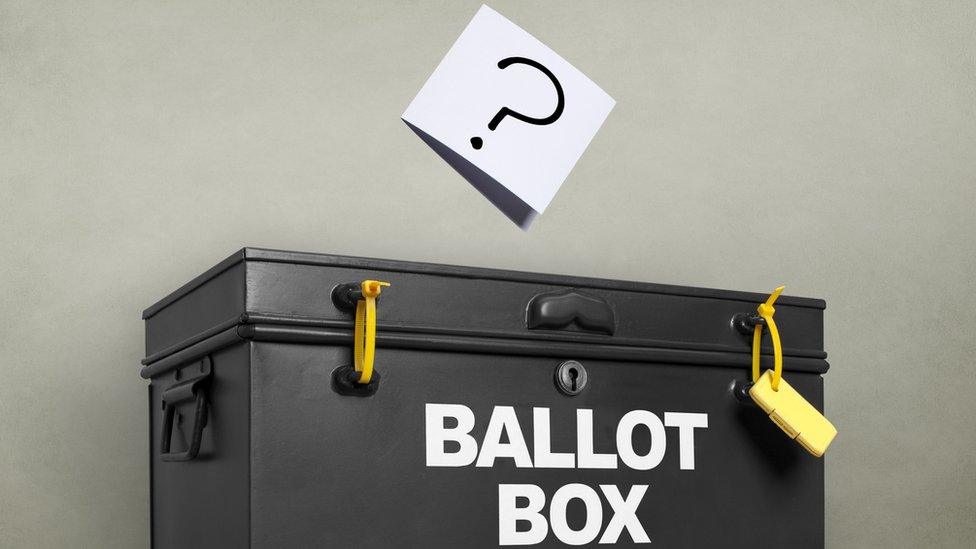
With one week to go until the Holyrood election, there seems to be little mystery about the final result - with only the SNP talking about forming a government. But there are still some key questions to be answered, which could have a huge bearing on Scotland's future.
Will the SNP secure an outright majority? Could they build a pro-independence majority with the help of other, smaller parties? Will the Conservatives hold off a Labour challenge in the battle for second place? And what are the factors which could help answer these questions?

Who will actually turn up to vote?
What could be key in this election isn't so much who votes for which party, but how many people turn out to vote at all.
Generally, for Holyrood elections, only about half of those who are eligible to vote actually do so. The average turnout since 1999 has been 53%.
That doesn't necessarily make things more unpredictable, although the Holyrood poll with the lowest turnout - 49% in 2003 - produced the "rainbow parliament" of seven different parties.
And the SNP overwhelmingly won lower-turnout seats in 2016 - the 41 seats with the lowest turnout all elected an SNP MSP, while the party only won three of the ten highest-turnout seats - suggesting that the current party of government may have little to fear from a quieter polling day.
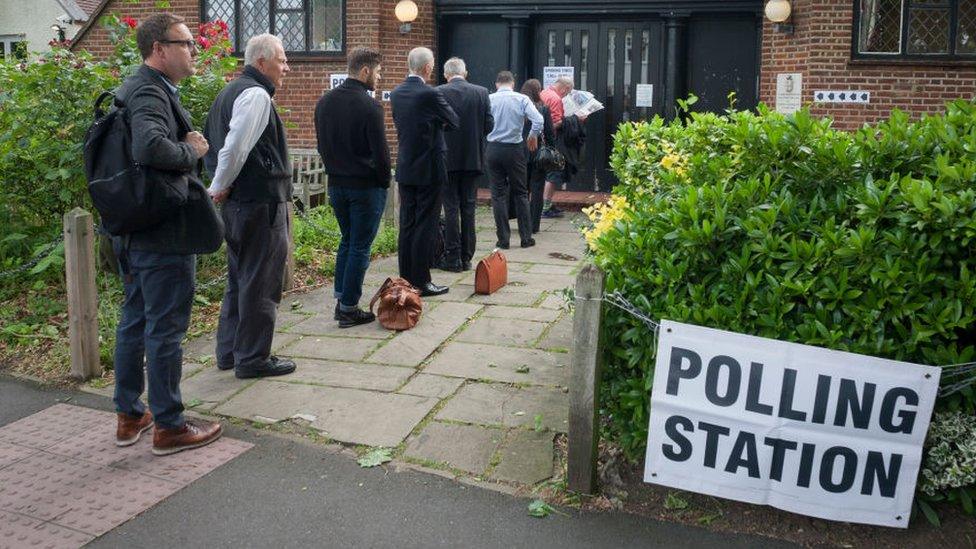
Will there be queues outside polling stations in 2021?
The question is whether the voters who come to the polls in 2021 will be different from those of previous years.
Older demographics are traditionally more likely to vote - but are also more likely to be adversely affected by Covid-19 and thus potentially nervous about leaving their homes.
Meanwhile a record number of people have signed up for a postal ballot, but they are presumably fairly politically engaged types who would likely have voted in person anyway.
People are also less likely to vote in elections where the result appears to be a foregone conclusion - and in this contest, only one party is actually talking about going into government. But who will prove the most successful in getting their supporters to show up and put a cross in a box on 6 May?

What impact will smaller parties have?
There are a total of 25 parties running in the Holyrood election. Everyone in Scotland will have at least 15 different choices on the regional lists, and in some areas the ballot paper will resemble a phone book.
Small parties have run for parliament before with varying degrees of success, but in 2021 there seems to be more interest in the idea than ever before - chiefly thanks to former first minister Alex Salmond re-entering the political fray as the leader of the Alba Party.
It is extremely hard to say whether Alba will have a breakthrough of its own and boost the pro-independence cause, or split the vote and cost the larger pro-indy parties seats. The same could be said of George Galloway's All for Unity group on the pro-UK side.
To win a single regional list seat, a party generally needs about 6% of the vote in an area. The usual margin for error on an opinion poll is 3%: with smaller parties hovering in single digits, pollsters are essentially saying they don't really know.
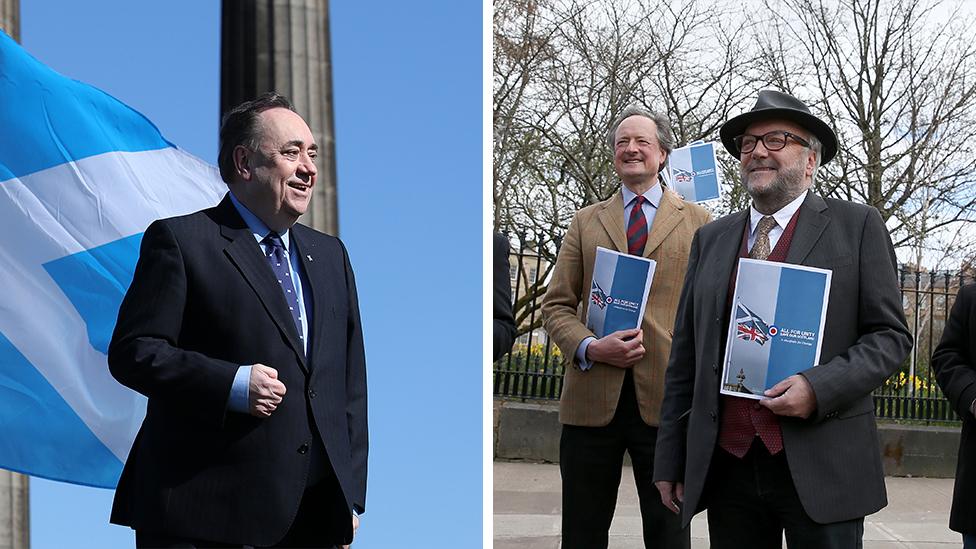
Will smaller parties like those led by Alex Salmond and George Galloway make a breakthrough - or change the debate?
The other unknown about smaller parties is whether they have changed the narrative around the election. They are chiefly pitching for list votes, but while there are two ballot papers in a Holyrood election there is only one campaign.
The SNP's plan for this election was to talk about independence essentially as a contrast between the leadership of Nicola Sturgeon and that of Boris Johnson. But the rise of Alba means Ms Sturgeon does not have complete control over the pro-independence side of the debate, and has found herself talking about borders, currency, the EU and all kinds of potentially sticky topics she would rather have put off until a future referendum campaign.
This will have gone down well with her pro-independence base, but what does it mean for the larger cohort of voters in "middle Scotland" who are either yet to be convinced or simply are not as engaged by the issue?

Who will win key marginal constituencies?
There are 10 constituencies with a majority of less that 5% going into this election - and nine of them are SNP targets.
These individual local struggles hold the key to parliament either continuing much as it is now, with a minority SNP government, or the party securing an outright majority.
Can Labour hang on to its key marginal constituencies - which is actually really all three of them, in Dumbarton, East Lothian and Edinburgh Southern?
Can the SNP claw back some of the seats the Conservatives took off them in 2016, like Edinburgh Central, Dumfriesshire and Aberdeenshire West?
At the other end of the scale, could they be at risk of a focused Tory challenge in some of their own more marginal seats, like Perthshire South and Kinross-shire, Edinburgh Pentlands or Moray?
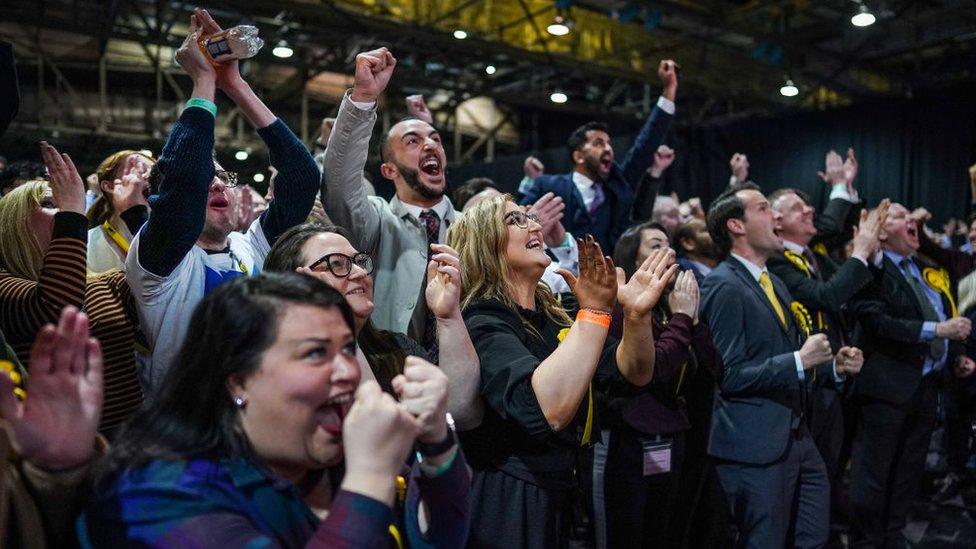
Physical distancing may mean fewer scenes of jubilation in sports centres as results are totted up
If you consider any seat with a majority of under 10% to be in play, then 16 of the 73 constituencies could potentially change hands. Of those, 12 are contests between the SNP and the Conservatives, currently split evenly between the two.
Once-dominant Labour are not in second place in a single seat with a single-digit majority, so will chiefly be focused on playing defence to hold on to what they have got. If they are to make gains, it will likely be via the regional lists.
How many seats a party can win from a regional list is directly affected by how many constituency seats it takes in that local area, so how much success the SNP has in these first-past-the-post contests will be pivotal to the overall result.

SIGN UP FOR SCOTLAND ALERTS: Get extra updates on BBC election coverage

What about the pandemic?
Circumstances have changed somewhat since the 2016 Holyrood election, when a historical figure named David Cameron was the prime minister. Both Scottish Labour and the Scottish Conservatives have changed leaders twice since then.
However the biggest upheaval has undoubtedly been the Covid-19 pandemic, which has changed the lives of everyone in the country.
Lockdown and social distancing mean that a lot of campaigning has been happening away from actual voters. Door-to-door canvassing was only allowed from mid-April; there are still no big rallies or street stalls. Handshakes are out of the question.
Parties have less contact with voters, and journalists and commentators are often watching the whole thing from home - it's hard to gauge the mood of the nation from such a distance, and harder still by scrolling through social media echo chambers.
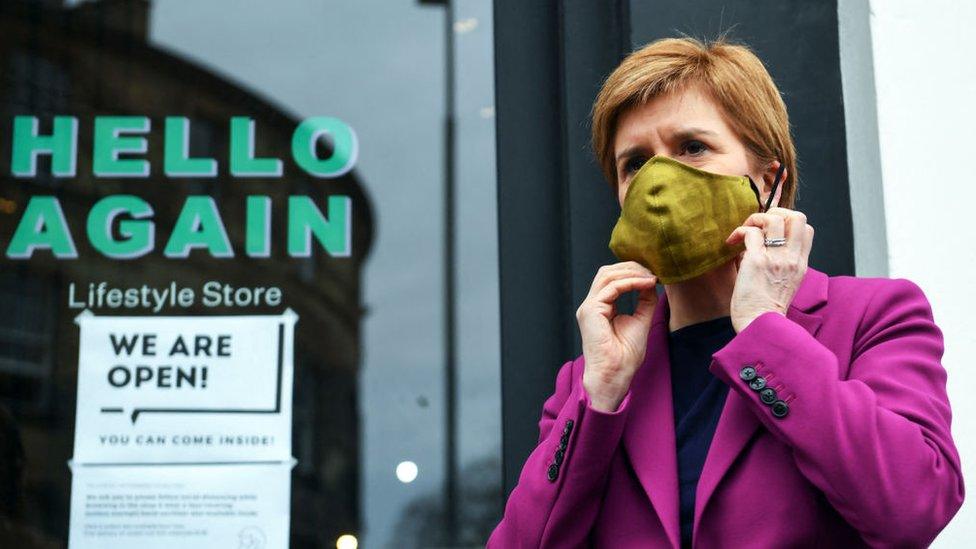
How will the easing of lockdown restrictions affect the mood of the nation as they head off to vote?
Now that lockdown is easing and people have one eye on the future, how might that play into how they vote on 6 May?
Will they want to move on from the Covid-19 era, or stick with the leaders who saw them through it?
Are they champing at the bit for change, or fearful about the precarious state of the economy and the spectre of a fresh wave of mutated infections?
The pandemic and the impact it has had on the lives of everyone in Scotland will undoubtedly be to the forefront in voters' minds, but does that distract from other issues - from the constitution to bread and butter devolved topics like education, health and justice - or sharpen the focus on them?

What's happening in regional strongholds?
Polling might provide a top-down picture of Scotland as a whole, but the nation will not vote in uniform fashion on 6 May.
Every party has its regional strongholds, areas which have traditionally voted one way or the other - and they can differ wildly from one end of the country to another.
For example, in 2016 the Lib Dems held the two safest seats in Scotland - while also losing their deposit in the majority of constituency contests. They won more than two-thirds of the vote in both Orkney and Shetland, but hovered around 2% in a number of Glasgow and west coast seats.
So the party polling at X% Scotland-wide tells you really very little about its chances in specific constituencies or even wider regions.
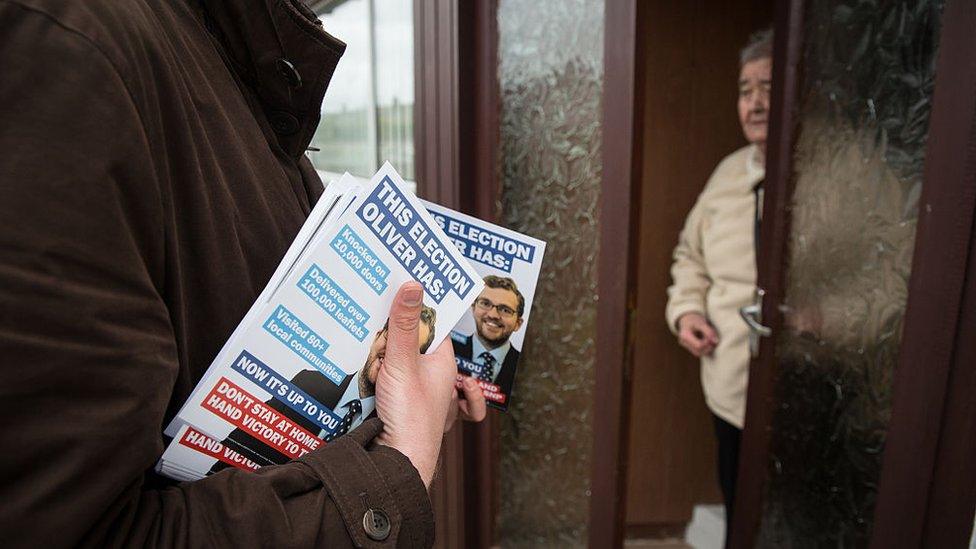
How campaigners are faring on the doorsteps around Scotland could play a key role in the final result
You can actually see some of these effects writ large on the electoral map. Consider the whole of Glasgow turning SNP yellow in 2016, or the band of Tory blue spreading across the Borders and Dumfries and Galloway.
Sometimes this can come down to a "personal vote" for a particularly popular local campaigner, or it can be driven by policy - like how the Greens poll well in leafy urban areas like Edinburgh, but have only once won a seat in the North East, an area more reliant on the oil and gas industry.
So while party leaders and national campaigns dominate coverage, much of politics remains local.
What will really decide the election is what is happening and how people are feeling in communities from Oban to Westhill, from Ayr to Dunbar to Elgin, and in every corner of Scotland.

POLICIES: Who should I vote for?
CANDIDATES: Who can I vote for in my area?
PODLITICAL: Updates from the campaign

